Historic Scotland Comes to Life at Stanley Mills
LEDGER AND PHOTOS RECALL LIFE AT STANLEY MILLS FROM VICTORIAN TIMES TO THE 1920s
A Victorian accounts book offering fascinating insights on the history of the Stanley Mills cotton weaving complex has been gifted to Historic Scotland.
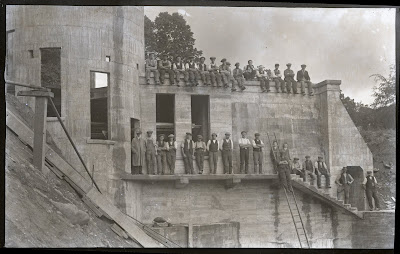
1921 turbine house under construction. This is a posed pictures of
the workers, with one rather daringly balanced the wrong way round on a
ladder. The health and safety conditions appear haphazard compared to a
modern building site.
The neatly hand-written ledger details the income and expenditure of the business and estate that Colonel Frank Stewart Sandeman purchased it in 1876.
It shows that in 1876-80 the weekly wage bill for the substantial workforce at the water-powered mills on the banks of the Tay outside Perth was between £107 and £172.
The greater part of this went to the salaries of those employed as millworkers but separate wage headings appear for those who specialised in weaving, bleaching and dyeing the cotton.
Wages recorded under ‘waterwheels’ and ‘turbine’ suggesting that there were mechanics whose job it was to maintain the mill machinery.
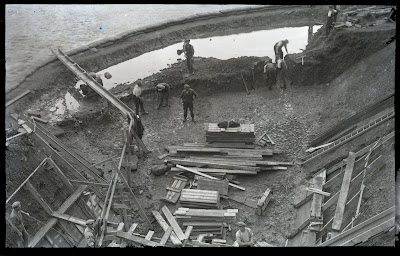
Men at work at the base of the turbine house
The ledger also reveals that Colonel Sanderman employed farmhands and gardeners to look after his estate. The dairy maid on the family farm collected 14d for a week’s work. Milk sales on the other hand brought in about £6 a week.
Indeed, the mills and other concerns appear to have been quite profitable with Col Sandeman depositing and impressive £240 with the Bank of Scotland in June 1876.
While the sums now seem tiny, the mills with their weavers, dyers, bleachers, engineers and other workers were at the forefront of the contemporary industry.
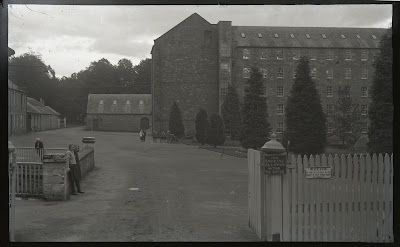
Two young women, and a man in a wheelchair, who is seen looking at an old cannon near the mill entrance. An indication of the safety risks involved at the cotton milling complex is that a sign insists that no smoking is allowed on the site.
The ledger bears witness to a huge technological change in at the end of the 1870s when the complex, which already dated back 90 years, made the switch from water wheels to modern, and much more efficient, water-driven turbines.
The book was gifted to Historic Scotland, which runs a visitor centre at Stanley Mills, by relatives of Phyllis Culbert, who died earlier this year.
Mrs Culbert’s family had worked at the mills for generations, with many of the menfolk being engineers.
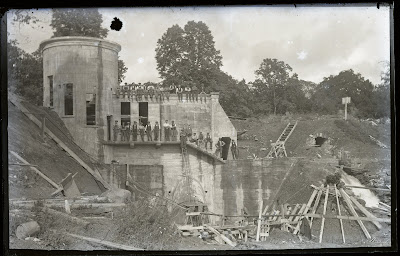
Posed pictures of the workers
In addition to the accounts book there were several glass plate negatives, including ones showing the building of the housing for a later turbine in 1921.
Hugh Morrison, Historic Scotland collections registrar, said: “We are very grateful to the Mrs Culbert’s son Ian for this generous donation.
“The accounts book provides fascinating insights into the operation and fortunes of Stanley Mills as well as Stanley House and farm, where Colonel Sandeman lived.
“They take us back to a time when improvements were being made to harness the power of the Tay to drive a thoroughly modern factory that was part of a global economic network.”
“Stanley House was badly damaged by fire in 1887 after which the Sandemans moved, so this ledger is a valuable survival and shows how it was at the centre of a diverse set of business interests that included farming, industry and property.”
The glass plate negatives, some of which show working practices that would be entirely unacceptable in today’s health and safety conscious world, are now being stored as part of Historic Scotland’s extensive photographic archive.

The Stanley Mills Ledger
Extracts from the ledger:
Below are details of some of the expenditure and income recorded in the Stanley House ledger.
● 16 June, 1876: wages to mills £111, 19s, 8d. Wages to dairy maid 14d.
● 22, September, 1876: sale of milk £6, 13s.
● 5, October, 1877: wages for farm £7, 13s, 9d, for Stanley House staff £4, 7s, 4d, for dyers £4, 11s, 5½d, weavers £16, 3s, 2d, water wheel workers £9, 1s, 10d, mills wages £116, 13s, 5½d.
● Weekly income around this time included: workers’ rents £9, 6s, 7d, sale of groceries £7, 19s, 5d, sale of cotton flock 17s, 6d and sale of milk £6.
● The first turbine was introduced in 1878. From January the wage payments, previously noted as being for workers associated with the water wheels changed to being for turbines – the first pay was £8, 8s, 1½d. Anthony Cook (2003, 112) says the first turbine delivered 200hp of power and was so successful that one of 400hp was then ordered.
● In April a calf was sold for £1, 17s 6d, in June a deposit of £1 on new machinery was paid to Joshua Hudlass, in July a sheep shearer received 5s and repairs to the mills cost 9s, 9d. During this period the entire outgoings and income for the businesses recorded in the ledger tended to be between around £230 and £470 a week.
● In 1879 there are records of men being paid £2, 12s, 3½d to break stones for road surfacing and £2, 7s, 10d for wood cutting.
● During 1880 there was a payment of £3, 15s in poor school rates. Estate rabbit catchers were paid £1 and 17s was spent on fishing lines.
● The fishing rights on the Tay were a valuable asset. One record shows fishermen employed by the estate were paid £5, 15s. The fishing was popular among anglers and were advertised in the press. A sum of 10s, 9d was paid on 14 January, 1880 to advertise in the Glasgow Herald and on 17 January a further 3s for advertising in the Scotsman. On 4 March a Mr Thorpe paid cash of £39, 15s, 2d for the fishings.
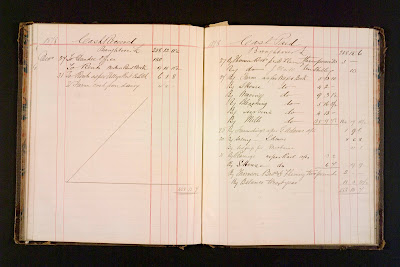
The Stanley Mills Ledger
Details:
● Historic Scotland would like to express its thanks to Ian Culbert, who now lives in Canada, for donating the ledger and negatives to our collection. They will prove a valuable resource for future research.
● Stanley Mills is 7.4 miles north of Perth, follow signs for Stanley Mills. Telephone 01738 828268. Open summer only, £5 for adults, £2.50 for children and £3.75 for concessions.
● One of the glass plate negative pictures appears in Stanley: From Arkwright Village to Commuter Suberb: 1784-3003, by Anthony Cook and Published by Perth and Kinross Heritage Libraries. The book is a detailed study of the village and contains a great deal of information about the mills and their workers.
● Historic Scotland is delighted to be supporting the 2009 Year of Homecoming with a series of initiatives including family trails, spectacular events and the creation of a Homecoming Pass for heritage attractions in association with other heritage organisations.
For more information, please see:
http://www.historic-scotland.gov.uk/
All photos courtesy and copyright of Historic Scotland.



















